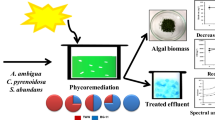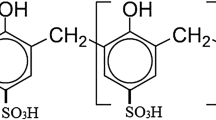Abstract
The biological treatment of textile effluent is enhanced by the use of zinc oxide (ZnO) nanoparticles for the reduction in chemical oxygen demand (COD) from its initial value of 1700 ppm. The present research investigated the effect of ZnO nanoparticles when microbial cultures of Pseudomonas putida and Pseudomonas aureofaciens were used to treat textile effluent in three-phase inverse fluidized bed bioreactor. The parameters like—size of ZnO nanoparticles, static bed height, superficial gas velocities and solid media particle size—together affected the COD reduction and all of these were investigated in this paper. ZnO nanoparticles of 280 nm reduced the maximum COD to 47 ppm (97.24%) at low gas velocity of 0.0027 m/s at 10% inoculum size and at a static bed height of 2.43 cm.
Graphical abstract








Similar content being viewed by others
References
Sur DH, Mukhopadhyay M (2017) COD reduction of textile effluent in three-phase fluidized bed bioreactor using Pseudomonas aureofaciens and Escherichia coli. 3Biotech 7(141):1–11
Koshy N, Singh DN (2016) Fly ash zeolites for water treatment applications. J Environ Chem Eng 4:1460–1472
Hairom NHH, Mohammad AW, Kadhum AAH (2015) Influence of zinc oxide nanoparticles in the nanofiltration of hazardous Congo red dyes. Chem Eng J 280:907–915
Savage N, Mamadou SD (2005) Nanoparticles and water quality. J Nano Res 7:325–330
Zhang Y, Ram MK, Stefanakos EK, Goswami DY (2012) Synthesis, characterization, and application of ZnO nanowires. J Nanomater 624520:1–22
Margeta K, Logar NZ, Siljeg M, Farcas A (2012) Natural zeolites in water treatment—how effective is their use. Water Treat 2012:81–112
Qu XL, Alvarez PJJ, Li Q (2013) Application of nanotechnology in water and wastewater treatment. Water Res 47:3931–3946
Saliby IJ, Shon HK, Kandasamy J, Vigneswaran S (2009) Nanotechnology for wastewater treatment: in brief, water and wastewater treatment technologies (edited). Encyclop Life Supp Syst 3:1–22
Tyagi PK, Singh R, Vats S, kumar d, tyagi s (2012) Nanomaterials use in wastewater treatment. International conference on nanotechnology and chemical engineering, Thailand, pp 65–68
Baruah S, Pal SK, Dutta J (2012) Anostructured zinc oxide for water treatment. Nanosci Nanotechnol Asia 2:90–102
Chang JH, Chang TJ, Tung CH (2009) Performance of nano- and nonnano-catalytic electrodes for decontaminating municipal wastewater. J Hazard Mater 163:152–157
Rodea-Palomares I, Boltes K, Ferna´ndez-Pin˜as F, Legane´s F, Garcı´a-Calvo E, Santiago J, Rosal R (2011) Physicochemical characterization and ecotoxicological assessment of CeO2 nanoparticles using two aquatic microorganisms. Toxicol Sci 119:135–145
Erkan A, Bakir U, Karakas G (2006) Photocatalytic microbial inactivation over Pd doped SnO2 and TiO2 thin films. J Photochem Photobiol 184:313–321
Ibanez JA, Litter MI, Pizzaro RA (2003) Photocatalytic bactericidal effect of TiO2 on enterbacter cloacae. Comparative study with other gram –ve bacteria. J Photochem Photobiol A 157:81–85
Baruah S, Dutta J (2009) Nanotechnology applications in pollution sensing and degradation in agriculture. Environ Chem Lett 7:191–204
Puay N, Qiu G, Ting YP (2015) Effect of zinc oxide nanoparticles on biological wastewater treatment in a sequencing batch reactor. J Clean Prod 88:139–145
Tan M, Qiu G, Ting YP (2015) Effects of ZnO nanoparticles on wastewater treatment and their removal behavior in a membrane bioreactor. Biores Technol 185:125–133
Gunalan S, Sivaraj R, Rajendran V (2012) Green synthesized ZnO nanoparticles against bacterial and fungal pathogens. Progress Natural Sci Mater Int 22:693–700
Zhang J (2011) Silver-coated zinc oxide nanoantibacterial synthesis and antibacterial activity characterization. International conference on electronics and optoelectronics (ICEOE), vol 3, Dalian, Liaoning, USA (IEEE, 2011), pp 94–98
Han J, Qiu W, Gao W (2010) Potential dissolution and photodissolution of ZnO thin films. J Hazard Mater 178:115–122
Sirelkhatim A, Mahmud S, Seeni A, MaohamadKaus NH, Ann LC, Mohd.Bakhori SK, Hasan H, Mohamad D (2015) Review on zinc oxide nanoparticles: antibacterial activity and toxicity mechanism. Nano-micro Lett 7:219–242
Seil JT, Webster TJ (2012) Antimicrobial applications of nanotechnology: methods and literature. Int J Nanomed 7:2767–2781
Zhang L, Jiang Y, Ding Y, Povey M, York D (2007) Investigation into the antibacterial behaviour of suspensions of ZnO nanoparticles (ZnO nanofluids). J Nanopart Res 9:479–489
Peng X, Palma S, Fisher NS, Wong SS (2011) Effect of morphology of ZnO nanostructures on their toxicity to marine algae. Aquat Toxicol 102:186–196
Xie Y, He Y, Irwin PL, Jin T, Shi X (2011) Antibacterial activity and mechanism of action of zinc oxide nanoparticles against Campylobacter jejuni. Appl Environ Microbiol 77:2325–2331
Padmavathy N, Vijayaraghavan R (2008) Enhanced bioactivity of ZnO nanoparticles—an antimicrobial study. Sci Technol Adv Mater 9:35–40
Franklin NM, Rogers NJ, Apte SC, Batley GE, Gadd GE, Casey PS (2007) Comparative toxicity of nanoparticulate ZnO, bulk ZnO, and ZnCl2 to a freshwater microalga (Pseudokirchneriella subcapitata): the importance of particle solubility. Environ Sci Technol 41:8484–8490
Raghupathi KR, Koodali RT, Manna AC (2011) Size-dependent bacterial growth inhibition and mechanism of antibacterial activity of zinc oxide nanoparticles. Langmuir 27:4020–4028
Jeng HA, Swanson J (2006) Toxicity of metal oxide nanoparticles in mammalian cells. J Environ Sci Health A 41:2699–2711
Sur DH, Mukhopadhyay M (2017) Process aspects of three-phase inverse fluidized bed bioreactor: a review. J Environ Chem Eng 5:3518–3528
Sur DH, Mukhopadhyay M (2018) Parameter estimation and optimization of COD removal of electroplating industry effluent. 3Biotech 8:84. https://doi.org/10.1007/s13205-017-1059-0
Shin C, Bae J, Lee E, McCarty PL (2011) Effects of influent DO/COD ratio on the performance of an anaerobic fluidized bed reactor fed low-strength fabricated wastewater. Biores Technol 102:9860–9865
Farabegoli G, Chiavola A, Rolle E (2010) Decolorization of reactive Red 195 by a mixed culture in an alternating anaerobic–aerobic sequencing batch reactor. Biochem Eng J 52:220–226
Zheng Y, Yu S, Shuai S, Zhou Q (2013) Color removal and COD reduction of biologically treated textile effluent through submerged filtration using hollow fiber nanofiltration membrane. Desalination 314:89–95
ConceiÒ«ão V, Freire FB, Carvalho KQ (2013) Treatment of textile effluent containing indigo blue dye by a UASB reactor coupled with pottery clay adsorption. Acta Sci 35:53–58
Su CC, Pukdee-Asa M, Ratanatamskul C (2011) Effect of operating parameters on decolorization and COD removal of three reactive dyes by Fenton’s reagent using fluidized-bed reactor. Desalination 278:211–218
Agarry SE, Ajani AO (2011) Evaluation of microbial systems for biotreatment of textile waste effluent in Nigeria: biodecolourization and Biodegradation of textile dye. J Appl Sci Environ Manag 15:79–86
Baban A, Yediler A, Avaz G (2010) Biological and oxidative treatment of cotton textile dye-bath effluents by fixed and fluidized bed reactors. Biores Technol 101:1147–1152
Haribabu K, Sivasubramanian V (2014) Treatment of wastewater in fluidized bed bioreactor using low density biosupport. Energy Procedia 50:214–221
Sokol W (2012) Optimal aerations in the inverse fluidized bed biofilm reactor when used in treatment of industrial wastewaters of various strength. Adv Chem Eng Sci 2:384–391
Sokol W, Woldeyes B (2011) Evaluation of the inverse fluidized bed biological reactor for treating high-strength industrial wastewaters. Adv Chem Eng Sci 1:239–244
Acknowledgements
Mr. Dharmesh H Sur acknowledges the help provided by Dr. Jaysukh Marakana and Mr. Chirag Savaliya of Department of Nanotechnology, V V P Engineering College, Rajkot. The author remains grateful for the support provided by the management of V V P Engineering College, Rajkot, Gujarat (India).
Author information
Authors and Affiliations
Corresponding author
Ethics declarations
Conflict of interest
This manuscript is the authors’ original work and has not been published nor has it been submitted simultaneously elsewhere. All authors have checked the manuscript and have agreed to the submission.
Electronic supplementary material
Below is the link to the electronic supplementary material.
Rights and permissions
About this article
Cite this article
Sur, D.H., Mukhopadhyay, M. Role of zinc oxide nanoparticles for effluent treatment using Pseudomonas putida and Pseudomonas aureofaciens. Bioprocess Biosyst Eng 42, 187–198 (2019). https://doi.org/10.1007/s00449-018-2024-y
Received:
Accepted:
Published:
Issue Date:
DOI: https://doi.org/10.1007/s00449-018-2024-y




